
Home
Mission
Overview of Project
Project Staff
Sponsors
Achievements
Checking, Illustrations
Upcoming Activities
Id and Species Lists
Protea Information
Protea Gallery
Growing Proteas
Interim Dist. Maps
Publications
Afrikaanse Inligting
![]()
Who is Flea-on-a-mouse?
(Pronounced: Flea-on-a-mouse)

Phloeonomus is the "surname" of one of the
most common beetle species in Protea heads. Alas, the poor
Phloeonomus I am speaking about does not even have a first
name! This is because he has not yet been described by
scientists, who must give "surnames" (genera) and
"first names"  (species) to all species of animal, plant and fungus
on earth. Understandably, with millions of insect species there
are very many without "first names" and quite a few
without "surnames". So we will call our beetle Phloeonomus
"sp." to indicate that he does not have a first
name. Other beetles, like the larger Green Protea Beetle, Trichostetha
fascicularis, have both a surname and a species name. [You
will of course recognize from this that `Protea' is the
"surname" and `cynaroides' is the "first
name" of what you know by the common name of King Protea,
and that all the plant species in the Proteaceae also have both
surnames and first names.]
(species) to all species of animal, plant and fungus
on earth. Understandably, with millions of insect species there
are very many without "first names" and quite a few
without "surnames". So we will call our beetle Phloeonomus
"sp." to indicate that he does not have a first
name. Other beetles, like the larger Green Protea Beetle, Trichostetha
fascicularis, have both a surname and a species name. [You
will of course recognize from this that `Protea' is the
"surname" and `cynaroides' is the "first
name" of what you know by the common name of King Protea,
and that all the plant species in the Proteaceae also have both
surnames and first names.]
What's more, poor Phloeonomus sp. does not even
have a common name. All this does not bother little Phloeonomus
sp. one little bit. He belongs to a group called the
"rove beetles". Rove Beetles are easily recognized
amongst beetles by having very small wings - so that you can see 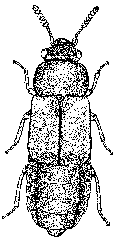 many of the
segments of the abdomen which stick out. These small wings are
merely the outer wings (elytra). They protect the delicate flying
wings, which fold up neatly under the elytra when not needed. In
fact, rove beetles are amongst the strongest flying beetles.
many of the
segments of the abdomen which stick out. These small wings are
merely the outer wings (elytra). They protect the delicate flying
wings, which fold up neatly under the elytra when not needed. In
fact, rove beetles are amongst the strongest flying beetles.
You will probably find other species of rove beetles if you look in a compost heap, or in the litter on any forest floor. However, Phloeonomus sp. lives in Protea heads. Because he flies so widely, and because he knows Proteas so well, he is going to teach us some of the secrets of the Protea family. He does not mind not having a first name: one day someone will give him a name. That does not mean that he cannot teach us a lot of interesting things. Phloeonomus will present interesting projects which you can do with your friends, sometimes with the help of your parents or teachers. In fact, I think Phloeonomus hopes that if he teaches you about proteas and the animals which live in proteas, perhaps you will become interested in ecology and taxonomy. And then, perhaps one day you will give him his species name!
Here are some of Phloeonmus's friends and enemies.
 Chirdica sp. A bug (Hemiptera) |
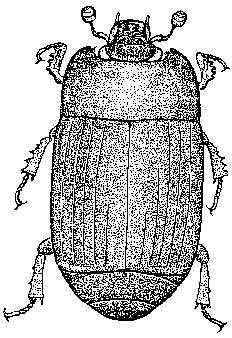 Platysoma capense. A beetle who eats the other beetles in the flowerheads |
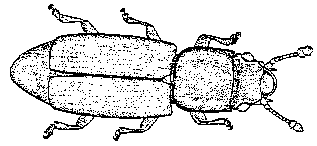 Protea Flower Beetle Phyconomus tricolor who prefers the Common Sugarbush Protea repens |
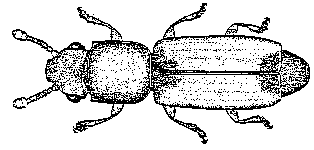 A Protea Flower Beetle Phyconomus sp. who prefers the Black-beard Sugarbush Protea lepidocarpodendron and feeds on pollen and nectar |
|
Back Phloeonumus Corner
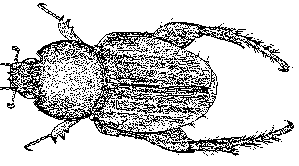 Diaplochelus longipes
Protea Monkey Beetle which feeds on pollen and nectar,
and may occur in large numbers in some flowerheads where
they congregate to have feeding orgies.
Diaplochelus longipes
Protea Monkey Beetle which feeds on pollen and nectar,
and may occur in large numbers in some flowerheads where
they congregate to have feeding orgies.